What are good stoves for a house on long-burning coal. Installation of a long-burning furnace
Wood-burning stoves are becoming more and more popular for homeowners. long burning. There are several reasons for demand: thermal efficiency, ease of installation, functionality. When choosing a stove, the principle of operation, design features, working and operational characteristics are taken into account.
Options for long-burning home stoves
Metal furnaces are not exclusively a foreign invention. The simplest convection models of furnace equipment existed in pre-revolutionary times. The device of such a stove "potbelly stove" was simple and inefficient, significant heat losses were observed during operation. The design required significant improvements, which happened in the future.Almost simultaneously, Canadian stoves appeared, which had a more efficient device than domestic potbelly stoves. The design provides for convection channels, ⅔ immersed in the combustion chamber.
Modern stove models are actually modified and redesigned for greater efficiency, derived from and. All offered stoves are divided into two classes according to the principle of space heating.
Hot air type
The first stoves heated the room exclusively by heating the air. Stoves with a built-in water circuit appeared much later.Modern convection ovens for a long-burning wood-fired home have several features that affect thermal efficiency and ease of use:
- Increased burning time - in a classic potbelly stove, firewood burned out in 1.5-2 hours. After modernization, the pyrolysis or gas generation process began to be used in the furnaces, the combustion chamber was enlarged. Working time from one bookmark increased to 4-8 hours.
- Efficient space heating - the design provides for convection channels, the walls of which are in contact with the firebox. Cold air is taken in and hot air is discharged through the channels. The design increased the efficiency of stoves from 80 to 92%.
- The principle of operation of the furnace is to increase heat transfer, the process of gas generation or pyrolysis is used. In fact, the fuel does not burn, but smolders. As a result of gas generation, the burning time increases and additional thermal energy appears from the afterburning of the released carbon dioxide.
Initially, stoves were designed to heat only the room in which they were installed. Adjoining rooms were not heated. There are solutions that allow you to heat the entire residential building. To do this, air ducts are connected to the air convection channels of the furnace, laid in each heated room. Wiring around the house effectively solves the problem of heating the entire building.
Hot water type
In fact, these are the same air-heating furnaces, but instead of convection channels, a design with a heat exchanger is used. The heat removal device is made in the form of a "water jacket" surrounding the furnace and smoke channels, or a coil built into the combustion chamber.Heating stoves for a long-burning house with a water circuit, designed to be connected to a radiator heating system or warm floors(after installation of additional equipment).
The principle of operation is in many ways similar to how it functions. However, there is one advantage. Most stoves are equipped with a hob for cooking, and also have glass built into the firebox door, which allows you to observe the flame.
Long-burning solid fuel stoves with a water circuit can be connected to any type of heating system, with a few exceptions. Allowed to use:
- in open and closed systems.
- and heat carrier.
Connecting batteries in furnaces with a built-in water circuit is carried out using special taps located on the body. The supply and return pipes are clearly marked in the operating instructions.
Which long burning stove is best for home
When deciding which stove to choose, several factors are taken into account: the operating time from one laying of firewood, the material from which the structure is made, the principle of heating, the power and model of the manufacturer. Each of these parameters affects the thermal and operational characteristics:
In addition to the above parameters, when choosing a stove, pay attention to its functionality: the presence of glass in the furnace door, hob and oven.
Arrangement of a long-burning stove in a private house
Installing a long-burning stove in a house with your own hands, thanks to simple installation, everyone can do it, provided they have minimal technical skills and the right tools.During installation work, you will need to closely follow the operating instructions provided by the manufacturer. General installation recommendations:
- The location of the furnace in the house is determined depending on the principle of its operation:
- Air-heating models are installed taking into account the movement of heated air flows. A distance of 1 m is left to the walls, which is necessary to ensure the operation of the furnace necessary quantity cold air.
- Models with a built-in water circuit are located in any part of the house that meets fire safety requirements.
- A mandatory requirement for the operation of a long-burning furnace is good ventilation in the house. In the room where the oven is installed, there must be windows that open, the ceiling height is at least 2.2 m. Supply and exhaust ventilation should provide three air exchanges in the room for an hour.
- It is better to put the stove in the house in a room with floors made of non-combustible material. Otherwise, the wooden floor under the stove is closed brickwork, iron or thick tempered glass.
Air heating furnaces, if necessary, are connected to a corrugated metal pipe through which air enters different rooms of the house. For better circulation of air masses, a fan is installed inside the air ducts.
Furnaces with a water circuit are connected to the heating system. The security group must be set.
Reviews about heating a house with a long-burning stove
Ten or fifteen years ago, it was believed that stoves are a cheap and inefficient option for heating residential premises. For this reason and ugly appearance furnace equipment was used to heat garages and utility rooms, country houses.A modern stove is fundamentally different from its predecessors: beautiful design, high heat transfer and an efficiency of up to 92%. Customer reviews help to see the pros and cons of stove heating at home.
What are the advantages of stoves
Factory furnaces are distinguished high quality assembly and beautiful design. Changes are made to the design and internal arrangement of most models from time to time in order to increase productivity and meet the needs and demands of consumers.Advantages independent heating private house using a long-burning stove:
- Self-installation of the furnace is possible.
- The operating time from one bookmark of firewood is 6-8 hours.
- Possibility to choose the principle of heating: air or water.
- Rapid heating of the room.
- Relatively low cost.
- Additional functionality.
What are the disadvantages
The disadvantages of long-burning furnaces are the same as for most pyrolysis and hot air equipment:- Demanding on the quality of fuel - firewood burned in a gas-generating stove should not be damp, the maximum humidity is not more than 20-25%.
- Cons associated with air-heating equipment - convection ovens are limited to heating one room. To warm adjacent rooms, you will need to install an air duct system, which is associated with additional material costs. Models with a water circuit do not have such disadvantages.
Furnace or boiler
Comparison of long burning stoves with solid fuel boilers, will help to conclude which equipment is preferable to install in a private house:- Heat transfer - furnaces and boilers have a high efficiency of up to 92%. Convection models are somewhat inferior in efficiency to the series with a water heat exchanger.
- Cost – Furnaces are cheaper than boilers.
- Functionality - boilers are designed exclusively for heating. Furnaces (some models) are equipped with a hob and an oven, which increases their application possibilities.
- Purpose - in the house of permanent residence, as the main source of heat, it is better to install a solid fuel boiler. Furnaces are more efficient when heating rarely heated buildings.
Not so long ago, almost the only affordable and popular way to heat country houses was an ordinary wood-burning stove. Such a device made it possible to quickly heat rooms, but had significant drawbacks during use: the constant need to throw up fuel and make sure that it does not burn out. Such heating caused a lot of problems for the homeowner.
But, despite all the inconveniences of stove equipment in suburban buildings, where it is not possible to connect to a centralized gas main, a wood-burning stove remains popular to this day. However, thanks to progress, such a heating system has undergone improvements and two types of wood-burning devices have appeared: appliances intermittent and prolonged burning of fuel. At the same time, the second type of equipment, which is also called gas generating equipment, is much more convenient and practical in terms of operation.
Features of the operation of gas-generating furnaces
 If we consider a standard stove device, then the firewood in it burns out in no more than 3-4 hours. In this case, a large release of heat occurs, which allows you to quickly warm up the country house, but as soon as the fire in the furnace goes out, the rooms become cool.
If we consider a standard stove device, then the firewood in it burns out in no more than 3-4 hours. In this case, a large release of heat occurs, which allows you to quickly warm up the country house, but as soon as the fire in the furnace goes out, the rooms become cool.
This results in the need for fuel apply at regular intervals which causes a lot of inconvenience, especially at night. Plus, such furnace equipment burns oxygen in the rooms, while most of the heat escapes into the chimney.
Furnace equipment for long burning is made of thick-walled sheet steel or cast iron. Structurally, such a wood-burning stove is distinguished by the presence of a firebox divided into two spacious compartments. At the same time, some modern models use a convection system or a water-type heat exchanger for more efficient heating of rooms in a suburban building.
The main feature of such heating systems is the ability to operate the furnace in several modes. If it is necessary to quickly heat up a country house, the device works like a conventional wood-burning stove. After the room warms up, the system is switched to a mode with long-term fuel burning, due to which it is maintained stable temperature level in the rooms. In this case, the fuel burns out rather slowly in conditions of lack of oxygen.
This effect was achieved by reducing the air supply by blocking the blower chamber and the gate. In this case, firewood smolders with a large release of combustible gases, which burn out in the afterburner, releasing enough heat to heat the cottage. This has made it possible to a large extent increase efficiency wood stove. On one tab of firewood, such a device will burn 3-4 times longer than a standard stove.
Why is it better to choose a long burning stove?
Wood-burning stoves with long-burning fuel have features that distinguish them from competitors. These advantages include the following options:
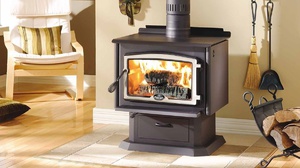
If we consider disadvantages of such equipment, the following problems should be highlighted:
- rather complicated setting of a long burning mode;
- the chimney for such a device should not be located in a horizontal position or have a large number of bends;
- due to the low temperature of the gases entering the chimney, condensation forms on its walls.
Before making the final choice towards a long-burning wood-burning stove, you need to know some nuances, which are not in the instructions for the equipment:
- the need for frequent cleaning of the chimney;
- collapsible type chimney should be assembled only in the direction of movement of gases;
- the stove must be installed at a certain distance from flammable materials.
This means that in wooden country houses, a concrete or metal base must be equipped under the stove device, and the minimum distance from the walls must be more than 120 cm.
Popular models of furnace equipment
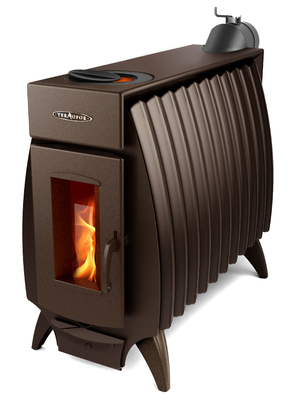 The most popular wood-burning stoves of long burning Canadian brand Buleryan. Although domestic companies are trying to keep up with foreign colleagues and presented to the consumer a Breneran wood-burning heating device, which is in no way inferior to its Canadian counterpart. At the same time, both heating units have the following advantages:
The most popular wood-burning stoves of long burning Canadian brand Buleryan. Although domestic companies are trying to keep up with foreign colleagues and presented to the consumer a Breneran wood-burning heating device, which is in no way inferior to its Canadian counterpart. At the same time, both heating units have the following advantages:
- the ability to work in a mode with long burning;
- due to the design features, such a device can be used as a hob;
- high quality materials used in the production of ovens.
By design, a long-burning device looks like a metal cylinder, girded with pipes, on top of which an air duct is put on to heat the rooms adjacent to the room where heating equipment is installed for heating a country or country house.
But, despite the great popularity of such wood stoves, they are not without drawbacks. In such a product, it is difficult to achieve high-quality tightness of the exhaust pipe and the cap for collecting condensate, which is located on the rear wall. AT recent times new models of Breneran stoves have a design that can be connected to a water heating system and therefore can heat not only small summer cottages, but also country cottages with a large number of rooms.
Another long-burning furnace device developed by domestic specialists is a heating unit Professor Butakov. This line is represented by a high-quality wood-burning stove of the Normal model. First of all, such a device is designed for consumers with an average level of income. But unfortunately, the price reduction affected the efficiency of the unit.
Such stoves for summer cottages with a long burning mode are equipped with an enlarged combustion chamber, due to which the burn-out time of the fuel increases. And thanks to equipping the heating unit with thermal convection elements, the quality of heat transfer in heated rooms improves. Also, such a product has a large hob, on which you can cook culinary masterpieces.
The products of domestic companies are practically not inferior to its foreign counterparts, despite the fact that the price of such heating devices is an order of magnitude lower than foreign products. Such equipment is an ideal value for money when it comes to heating country houses and country buildings.
What should you pay attention to when buying?
When choosing a stove for long-term burning, you need consider certain factors, which affect the main characteristics of the heating unit. Experts advise paying special attention to the following parameters of wood-burning stoves and rooms to be heated:

A very important parameter that must be paid attention to when buying a long-burning stove is power of the main unit, which affects its size. If you install a large wood-burning stove in a small room, then in addition to taking up a lot of already insignificant space, it will warm up the air so much that it will be impossible to stay in the room. In turn, the use of a small unit in a large country house will lead to the fact that the stove will work for wear.
Heating stoves
long burning
Heating furnaces of long burning for the house
Real brick heating stoves on long-burning wood are superior in many respects to other types of heating. A significant stone mass allows you to store a lot of heat, which the stove gives off to the house during the day. Two loads of firewood in cold weather is usually enough for kindling, and in frosty weather a third bookmark can be added.
The brick oven creates an exceptionally comfortable atmosphere in the house. The reason is that the furnace with its radiant heat mainly heats the surrounding objects and the human body, and not the air. And the stove "breathes". During the kindling, the stove releases the accumulated moisture, and when it cools down, it absorbs it, maintaining the humidity in the house in perfect condition.
Using a wood-burning heating stove is quite safe and you can safely go to bed when the last load of firewood is completely burned out. Our furnaces have a number of completely unique properties thanks to the technical excellence of the designs. Want to know more?
Geography of works
Switzerland
Advantages
The heating furnace must withstand thousands of kindling cycles and at the same time not collapse, prevent smoke from entering the room. We design furnaces strictly individually, guided by experience, engineering developments, rules for the production of pipe and furnace works, and current building codes and regulations.
The stove ventilates the room
One of the internal circuits of the furnace is responsible for this most important function. Fresh air from the street enters the furnace, heats up and enters the upper part of the room. In the meantime, oxygen-poor home air is removed and utilized. While the stove is still warm and gives off heat to the house, this built-in ventilation system also works. The intensity of ventilation can be adjusted with special valves, with the movement of one hand.
Climate control humidity
Our furnaces "breathe". During the kindling, the stove releases the accumulated moisture, and when it cools down, it absorbs it, maintaining the humidity in the house in perfect condition.
Quick kindling
In a stone oven, an average load of firewood burns out within 1-2 hours, and heat is stored in a large stone mass, from 4 tons. Firewood burns quickly and cleanly without producing creosote. The surface of the oven remains within 60°C, it is safe for children and animals. When it is below -10°C outside, the stove is heated daily, 1 hour is enough. A frozen house can be heated up in 3 hours using a special kindling turbo mode.
Payback 5 years
If you heat the house with a wood-burning stove, one timber truck will last for three years. One kW of heat from firewood is 10 times cheaper than electricity. When burning 1 kg of firewood, about 5 kW of heat is released, 80% will be used to heat the house. A wood burning stove pays for itself in 5 years.
Exceptional durability
A rare oven serves without overhaul more than 5 years in the mode of year-round operation. Our ovens are an exception. The life cycle (resource) of the furnace reaches 20 years. A common cause of furnace failure is uneven thermal expansion of the structure. We are successfully solving this problem.
Thermal engineering calculation
The power of the stove should be sufficient to heat the house even in frost. We calculate constant heat loss carried by the house. Knowing the temperature that you consider comfortable for yourself in the house and seasonal fluctuations outside the window, we calculate the power of the stove.
Beauty in the interior
The furnace door with glass will allow you to admire the play of the flame. Exquisite tiling will turn the stove into a pearl of the decor.
Heating stoves
Declaration of Technology
customers
inventions
Heating stoves
Features of work
Features of the brick heating furnace
The stove, when it is below -10 ° C outside, needs to be heated daily, 1 hour is enough. In a stone oven, an average load of firewood burns out quickly, within 1-2 hours, and heat is stored in a large stone mass, from 4 tons. Firewood burns quickly and cleanly without producing creosote. A heated oven gives off radiant heat to the room for a long time. The surface of the oven will be warm, remaining within 60°C. The stove does not dry out the air in the room.
Turbo heating mode, if the house is cold. Having made the first heating - the laying of firewood will completely burn out in half an hour - close the gate and open all the other doors (firebox, stuffing box and cleaning) for about an hour and a half. Equivalent to 8-hour operation of a 2 kW electric heater. Then make a second heating - already for the furnace itself.
Economy. If you heat the house with a wood-burning stove, one timber truck will last for three years. One kW of heat from firewood is 15 times cheaper than electricity. When burning 1 kg of firewood, about 5 kW of heat is released, and even if 20% of this heat “flies out into the chimney”, 4 kW will be used to heat the house. The heat loss of a house near Moscow in the cold season averages 0.1 kW per 1 m2 per hour. Let's calculate: a real stone wood-fired heating stove fully pays off in 5 years, when compared with electricity heating at a suburban tariff.
Thermal engineering calculation of the room. With it, we begin work on the project of creating a heating furnace. After all, the power of the stove should be sufficient to heat the house even in frost. Taking into account the characteristics of the materials, the thickness and area of walls and ceilings, the number and area of windows and doors, the height of the ceilings, we calculate the constant heat losses incurred by the house. And these losses will be the higher, the higher the temperature difference between inside and outside. Knowing the temperature that you consider comfortable for yourself in the house and seasonal fluctuations outside the window, a long-term wood-fired heating stove will receive power - with a sufficient margin. The mass, volume and surface area of the furnace depend both on the power and on the design of the furnace - Russian or Dutch.
ACQUAINTANCE
Formulation of the problem
DESIGN
PREPARATION
SUPPORT
Which stove model to choose?
"Stove Classics" specializes in two basic models of heating stoves: a Russian stove and a Dutch stove. Let's take a quick look at the advantages of each model so that you can determine which one is more suitable for your home.
|
Characteristic |
Russian oven |
Dutch oven |
|
Heating and cooking. |
Heating in mild winters, perhaps - cooking. |
|
|
Design |
Genius design. A virtual complex smoke channel without physical partitions, but also without mixing flows, two stable vortex circuits for fuel afterburning. A special form of the arch of the crucible (three-centered barrel). The walls are quite massive. |
Classic, time-tested design. Modified duct-bell, with a sequential gas convector. Channels for furnace gases are physical, brick. The walls are thin or medium thickness. |
|
Dimensions and heat capacity |
Large dimensions in plan (furnace base) and high heat capacity, you need to heat less often (once a day). |
Small and medium dimensions in plan (furnace base), medium heat capacity, it is necessary to heat more often (up to 2 times a day) |
|
Heating and cooling rate |
Heats up slowly and cools down slowly. |
Heats up quickly, cools down quickly. If you do not close the damper in time after kindling, it cools down quickly. |
|
Heat dissipation |
||
|
Efficiency (coefficient of performance) |
High, efficiency up to 80% (surprising and unattainable for other thermal devices). |
Increased for furnaces of this type, efficiency up to 50%. |
|
Fuel Requirements |
Absolutely any quality firewood burns completely, without soot and soot. A chimney sweeper is not needed. |
We need good firewood. Low-quality, ash fuel forms soot. The chimney needs to be cleaned periodically. |
|
Safety |
The most complete, the fire is only in the very depths of the furnace. For the same reason, it does not give sparks. |
A pre-furnace sheet is needed, coals may fall out. |
|
Aesthetics |
Decorative facing with tiles turns the Russian stove into a real work of art. |
You can equip the door with glass and enjoy the play of the flame. As a rule, it is faced with tiles. |
|
Facilities |
It is equipped with a bench (mat, flooring) made of wood, in the upper part of the furnace. |
It can be equipped with a bench for rest around the perimeter of the furnace. |
|
In the oven you can cook delicious and healthy food. Sleeping on a Russian stove is the most restorative. |
For heating only. |
Heating stoves
Which oven to choose?
Acquaintance
Formulation of the problem
Design
Digital engineering, design and costing
Training
Facility completion and production schedule
Creation and lining of the furnace, finishing of the steam room
Delivery of the object and detailed instruction
Support
Support throughout the furnace lifecycle
Heating stoves
Now we will tell you about heating stoves a lot of things that you probably never knew, but always hoped to meet in search of the perfect heating system for your home! Real brick heating stoves on long-burning wood are superior in many respects to other types of heating. A significant stone mass allows you to store a lot of heat, which the stove gives off to the house during the day. Two loads of firewood in cold weather is usually enough for kindling, and in frosty weather a third bookmark can be added. The brick oven creates an exceptionally comfortable atmosphere in the house. The reason is that the furnace with its radiant heat mainly heats the surrounding objects and the human body, and not the air. And the stove "breathes". During the kindling, the stove releases the accumulated moisture, and when it cools down, it absorbs it, maintaining the humidity in the house in perfect condition. Let's compare: in order to feel good in a room, a person needs a temperature of 22 C when heated by batteries (central heating or from his own boiler), while a stone stove creates the same comfort even at 18 C. Using a wood-burning stove is quite safe and you can safely move away to sleep, when the last bookmark of firewood completely burned out. Our furnaces have a number of completely unique properties due to the technical excellence of their designs. Want to know more? Features of the brick heating furnace. In a stone oven, an average load of firewood burns out quickly, within 1-2 hours, and heat is stored in a large stone mass, from 4 tons. Firewood burns quickly and cleanly without producing creosote. A heated oven gives off radiant heat to the room for a long time. At the same time, the surface of the stove will be warm, remaining within 60 C. The stove does not dry out the air in the room. Furnace location and foundation requirements. We will not dwell on this question in detail, since for a correct answer to it, many nuances must be taken into account. When starting a project, we carefully study the problem statement and develop a number of technological solutions, which will then find their application in the engineering model of the heating furnace structures. Thermal calculation of the room. With it, we begin work on the project of creating a heating furnace. After all, the power of the stove should be sufficient to heat the house even in frost. Taking into account the characteristics of the materials, the thickness and area of walls and ceilings, the number and area of windows and doors, the height of the ceilings, we calculate the constant heat losses incurred by the house. And these losses will be the higher, the higher the temperature difference between inside and outside. Knowing the temperature that you consider comfortable for yourself in the house and seasonal fluctuations outside the window, a long-term wood-fired heating stove will receive power - with a sufficient margin. The mass, volume and surface area of the furnace depend both on the power and on the design of the furnace - Russian or Dutch.
The use of firewood as fuel has not lost its relevance for many reasons. This is the territorial inaccessibility of the gas pipeline, and the high cost of electricity as a resource for heating. Firewood is a renewable type of fuel, so it is used to heat country houses, summer cottages, cottages.
- These are heaters with fuel burning for about 6-10 hours, depending on the model. There are models with a longer burning time of up to 5 or 8 days. Long-burning furnaces have become popular in Russia in the last decade, but they have been used in Europe for more than 40 years. The main reason for their popularity is fuel economy.
They are made of cast iron and steel and operate in two modes.– fast heating of the room and maintenance of temperature in the set level. In the first, firewood burns quickly, as in a conventional stove.
In the second mode, the fuel burns slowly with limited access to oxygen and releases gas, which then also burns. As a result of a long combustion process, more heat is released from one batch of fuel than with conventional fuel.
Principle of operation and scope
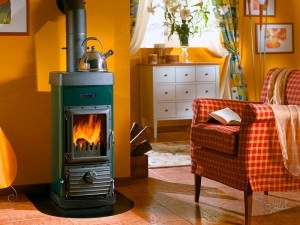
The main difference between a long-burning furnace and a traditional one is the principle of operation. First, firewood or set on a grate and set on fire. Then, the firebox door closes and the smoke exhauster turns on.
Under the influence high temperature, fuel forms volatile substances: carbon monoxide, hydrogen, nitrogen and steam. They enter the second furnace and burn out. The released heat enters the bottom firebox to maintain a constant high temperature to keep the fuel smoldering.
Installed in the oven to increase the heat transfer coefficient. But they run on electricity, therefore, together with them, allowing forced ventilation to be replaced by natural ventilation in the event of a power outage.
Used for heating private houses, cottages and small industrial buildings. The burning time of the fuel is from 5 hours to 5 days, depending on the model. There are models with a water circuit, which allows you to connect to a water heating system.
In this case, using a long-burning stove, you can heat a two-story residential building or cottage.
Advantages and disadvantages
Main advantages:
- High level of efficiency from 75 to 85%.
- Economical fuel consumption.
- Renewable fuel.
- Low cost fuel.
- Long service life– about 50 years old.
- Automatic or mechanical adjustment of combustion gases.
- When installing, there is no need to build a foundation.
- Interesting exterior design, allowing you to combine with any interior.
- There are models with the possibility of using briquettes from compressed sawdust or coal.
- Environmental friendliness- since in environment much less combustion products enter compared to a conventional furnace.
Main cons:
- Difficult setup system.
- Using only dry fuel with a humidity level of not more than 20%.
- The chimney must be straight, with access for cleaning.
- Condensation in the chimney because the smoke is at a low temperature.
Humidity solid fuel at home is difficult to determine, so there is a risk of using wet firewood. This can further lead to excessive formation of carbon dioxide, harmful resins.
Types and design
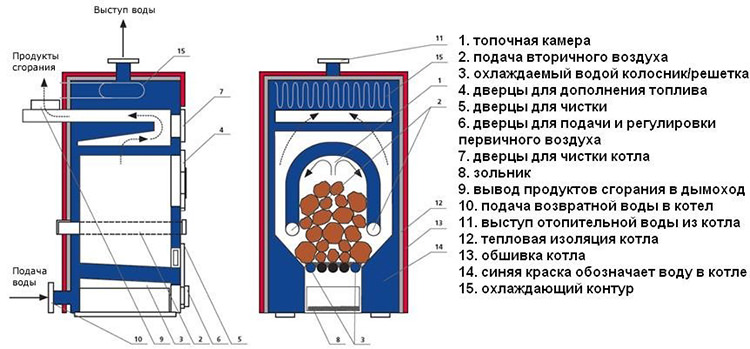
Furnace device
Long-burning heaters are divided into:
- Thick Wall Furnaces with a multi-turn system for passing smoke.
- Furnaces with external walls made of pipes. Depending on the model, hot air or hot gases from the furnace pass through them.
- Heater with water circuit and the ability to connect to a water heating system.
- Furnaces for heating with a hob.
The latter option can be used for continuous cooking or as a backup in case of a power outage. Models with a hob are installed in the kitchen and this option is preferable for a country house where they live permanently or visit every weekend.
The furnace consists of a furnace, which is divided into two parts. The large size of the firebox allows you to lay a large amount of firewood.
In the first part of the furnace, a very slow combustion of fuel occurs with limited air access, the resulting gas enters the upper furnace and burns out. The chambers are separated by grates and a special grate. Under the firebox there is an ash pan to collect the residues of the combustion product.
Model prices
The cost depends on the manufacturer, design, exterior finish, the duration of the burning time of one bookmark, the type of fuel. Also, the cost is affected by the power of the boiler, the heating area, the presence of a water circuit.
The prices shown may differ from retail outlets or online stores, but on average they are:
Buleryan PO-100
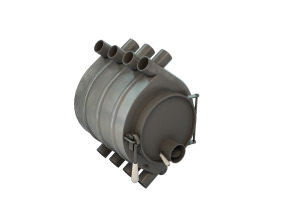
Russian production, software for space heating up to 45 sq.m, price - 11,400 rubles.
BRENERAN-AQUATEN AOTV-14 type 02
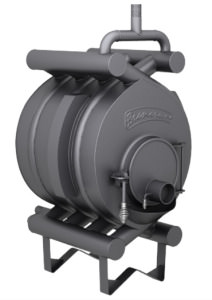
Russian production, for rooms up to 400 m3 with a water circuit, the cost is 49,900 rubles.
Mini S Stropuva
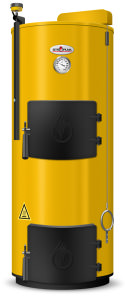
Producing country Lithuania, for rooms ranging from 30 to 80 sq.m, the price is 60,600 rubles.
LAWA (Ferlux)
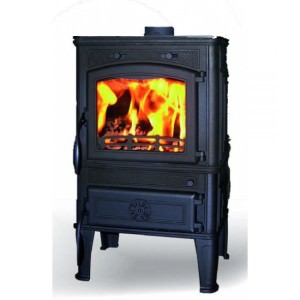
From the Spanish manufacturer, for rooms up to 80 sq.m the price is 56,607 rubles.
Buderus Logano S121-38
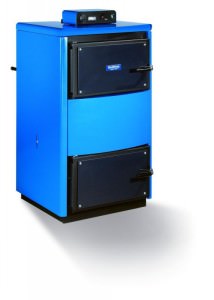
Made in Germany, price 109,120 rubles.
S40U (station wagon) Stropuva
Producing country Lithuania, heated area from 200 to 400 sq.m, cost 127,995 rubles;
When buying, you should decide on the power of the furnace. It is selected depending on the heated area. For large houses, it is advisable to select a heater with a water circuit, this will ensure uniform heating of the room.
When buying, you need to make sure that there is a guarantee in order to avoid unforeseen situations. Also, you need to check the availability of a quality certificate.
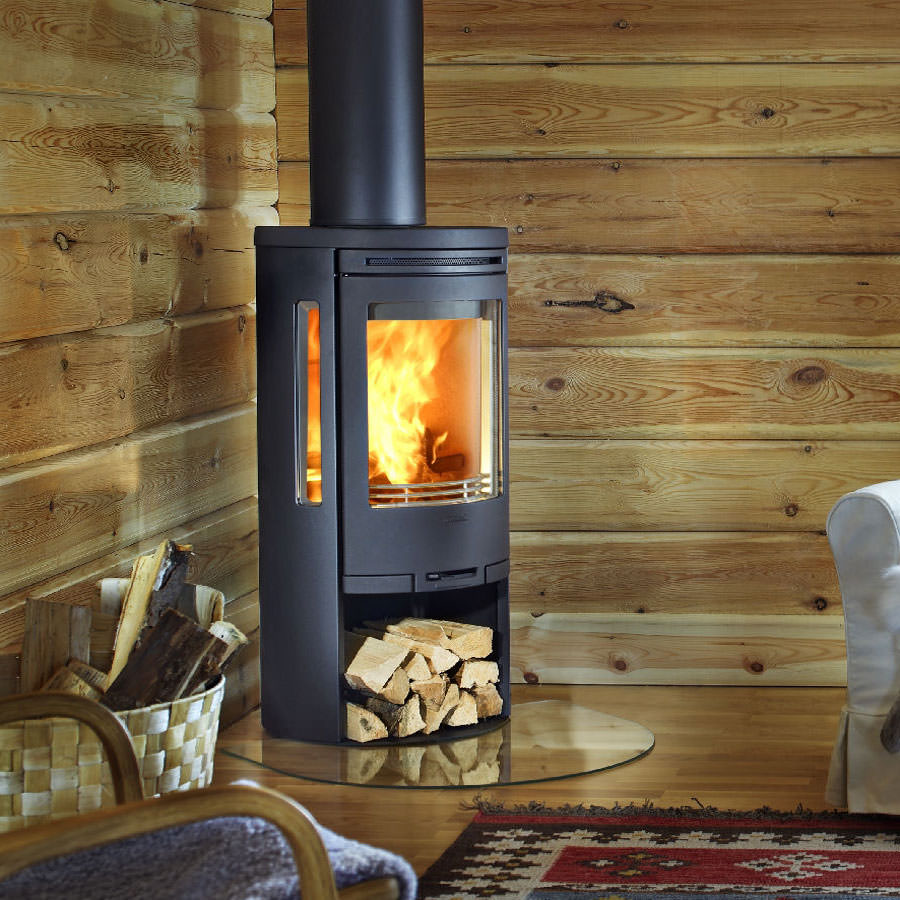
The chimney must be insulated, this will help prevent condensation inside the pipe. Also, it must be made collapsible so that it can be easily cleaned of accumulations.
For the stove, you need to use only dry firewood or ready-made compressed sawdust briquettes. When using insufficiently dry firewood, a substance is formed from a mixture of combustion by-products that prevents normal operation long burning stoves.
If insufficiently dry firewood is used for a long time, the heater will become unusable. Since it is impossible to check the moisture level of firewood at home, measures should be taken to clean the firebox from the resulting soot.
There is another option - to additionally dry firewood in small batches in the house near the stove.
But this is not very convenient for a number of reasons:
- Humidity level rises in room.
- Firewood must be placed at a certain distance from the stove otherwise, spontaneous combustion may occur. Being at a sufficient distance, about a meter, depending on the design, the logs may not have time to dry enough for the next bookmark.
- small insects who fell asleep in firewood in the cold in a warm room will wake up and cause a lot of trouble.
In order to clean the firebox from the formed soot, it is necessary to carry out the combustion process in a fast mode approximately once every few months. This will remove all carbon deposits, but the design of the heater will overheat, as it is not adapted to such thermal loads. In this case, it is better to use firewood from aspen.
Installation can be done by hand or with the involvement of professionals. When installing on your own, the heater must be strictly horizontal. When using for the first time, you should carefully inspect the chimney and the design of the furnace. This will prevent smoke ingress and disruption of operation.
Wood-burning stoves for giving long burning are used to fill the room with heat without constant regulation of the combustion process and practically without ash and soot waste. Therefore, in most of them there is no blower-ash pan, as in the usual heating systems. The installation of such a fireplace is the best way create a cozy homely atmosphere with visible fire with minimal maintenance and little firewood.
Long-burning stoves can be chosen for the home, for a bath, with simple heating of the room or with additional functions of the hob, with a water or air circuit for heating neighboring rooms. It is worth considering in more detail the most common types of such structures and their features.
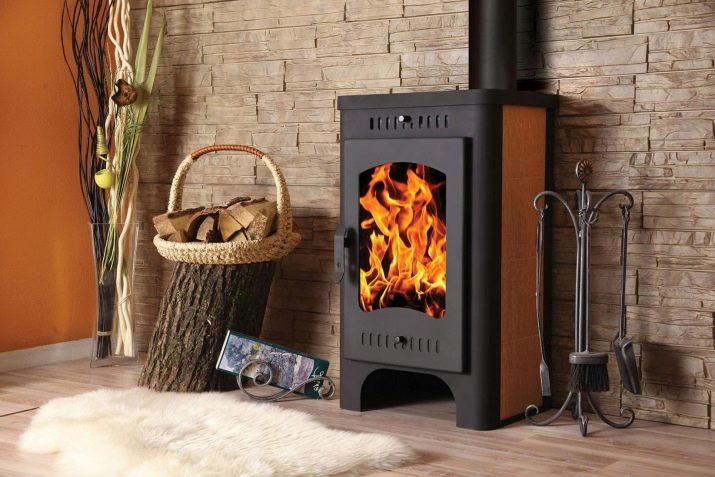
Kinds
Prefabricated fireplace stoves
According to the installation method, stoves can be prefabricated options and more complex models that need to be built into the interior. If you do not want to carry out complex construction works, that is, the opportunity to buy a factory model, the body of which is made of cast iron and equipped with transparent doors. In the kit of such furnaces there are often chimneys, which are fixed vertically above the firebox. These devices on legs are easy to carry, and it is possible to install them in a new place if necessary.
Embedded
For a small room of 20-30 sq. m. a compact model of a built-in fireplace-stove on long-burning wood is quite suitable. The facade can be lined with bricks or natural stone, and inside there is a factory-made cast-iron firebox with a transparent damper. The advantages of such a project are that you can implement any fireplace design to your liking and organize additional functions: stoves, countertops, heating circuits.
For a bath
Features of fireplace stoves for a bath in their increased moisture resistance and compactness for a small room. Bath models on long-burning wood come in ready-made options, which are easily installed in the steam room. Cases are made of high-strength stainless steel, transparent doors from the tempered glass. Most designs provide for regulation of the heat supply, and the dimensions of such products do not exceed 1000 x 800 x 700 mm, which allows them to be easily transported and installed in any corner of the bath.
The most popular and high-quality domestic models of long-burning bath stoves-fireplaces are Teplodar, Termofor and Ermak, and imported ones are Finnish Harvia and Kastor.
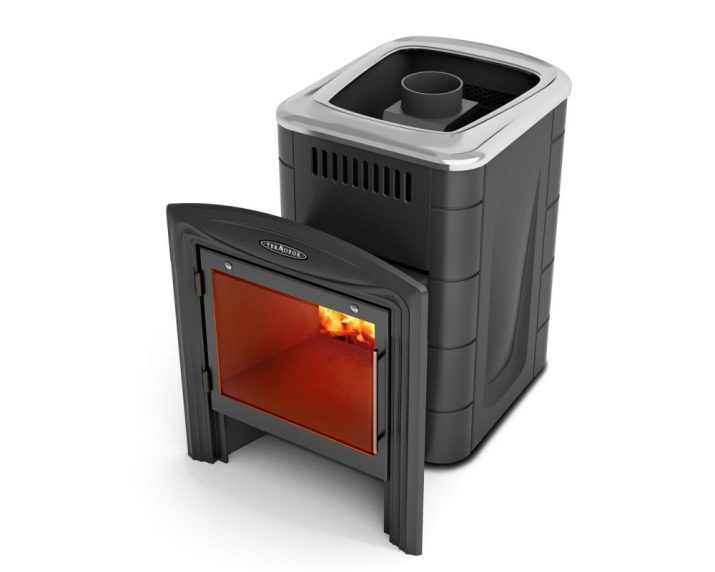
with hob
It is very convenient to combine two functions of stove-fireplaces with a hob. It is optimal to install them in the kitchen for heating it, with which it is convenient to cook dishes on an open natural fire. An example is the Okhta model with a solid black steel body, a cast-iron firebox and a framed single-leaf tempered glass door. On a single-burner ceramic hob, you can boil a kettle, heat soup or cook dinner in a short time. Due to its small dimensions, this stove is suitable even for a small country kitchen, and its appearance with burning firewood is very attractive.
With water or air circuit
Factory models of fireplace stoves with a water or air circuit allow not only to heat the room in which they are located, but also to supply other rooms in the house with heating and warm water. They can be connected to a complex system of pipes several tens of meters long, through which heated water enters radiator batteries in neighboring rooms or is discharged to a tap in a bathroom or bath. The average power of such systems is 9-11 kW, which is quite enough for heating one-story building with 2-3 rooms even in severe frosts. Of the most common fireplace stoves with a water circuit, Angara-Akva and Pechora-Akva can be noted.
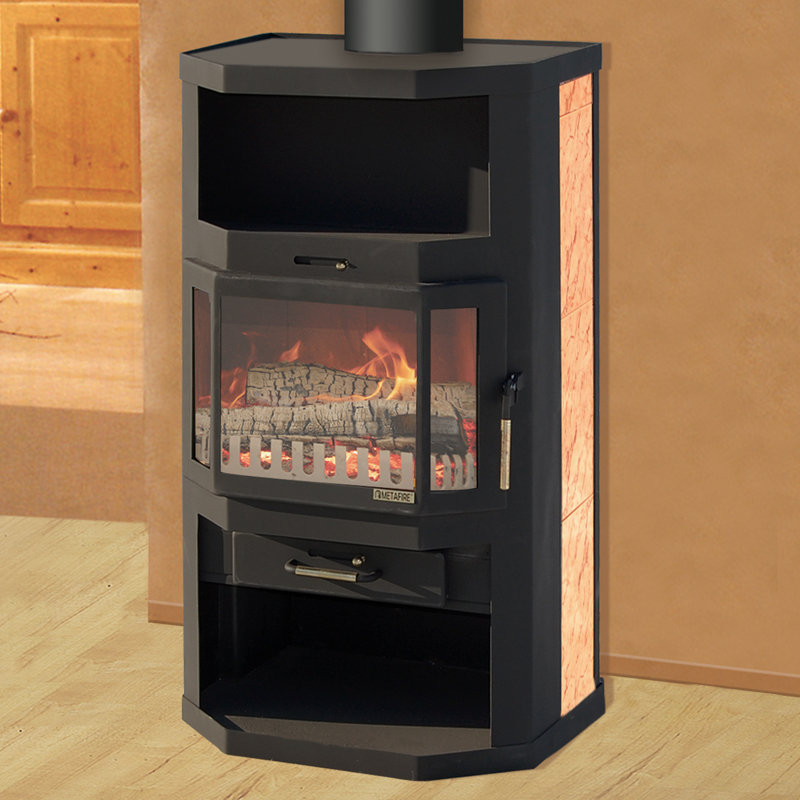
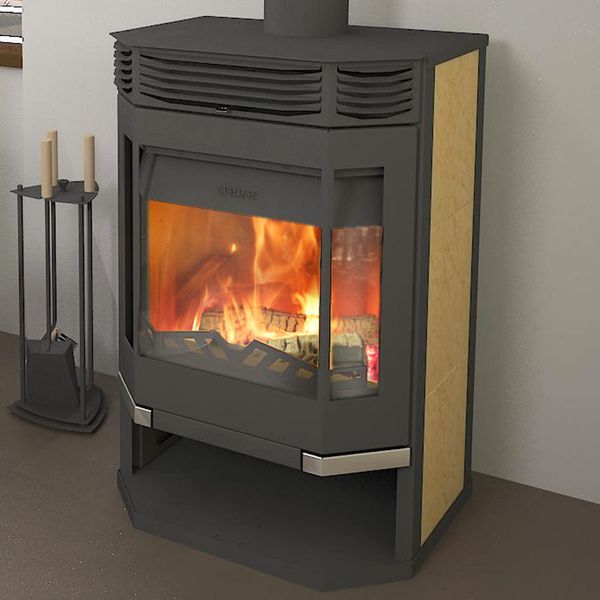
The air circuit fireplace stove uses hot air for the local heating system in the house. Through pipes divorced from the heating device, it penetrates into other rooms. The advantages of this method are greater reliability, unlike water systems, less pressure acts on the air pipes, and they do not run the risk of suddenly breaking through. Among the shortcomings, it is worth noting that the air system is not suitable for rooms with ventilation: kitchen, bathroom, toilet.
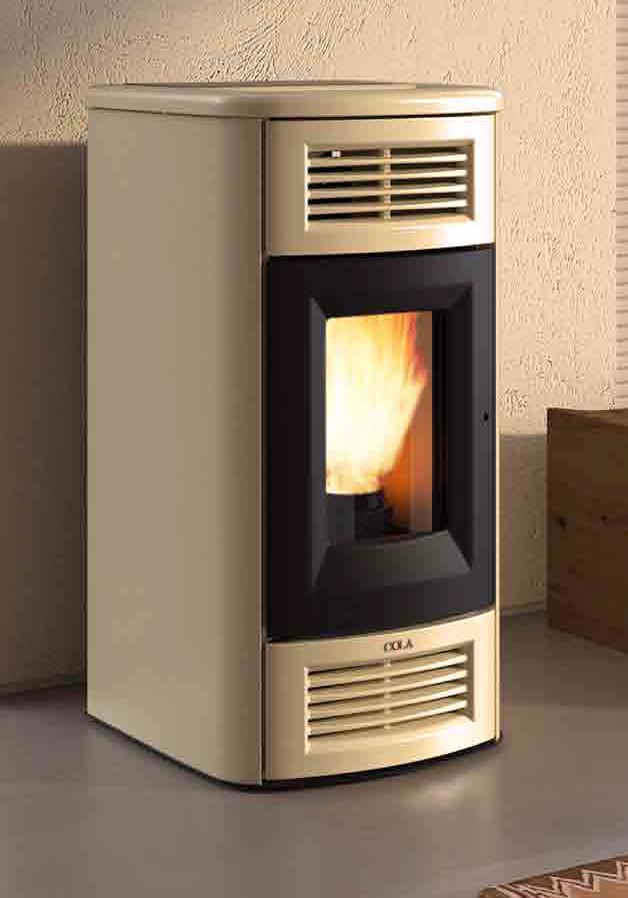
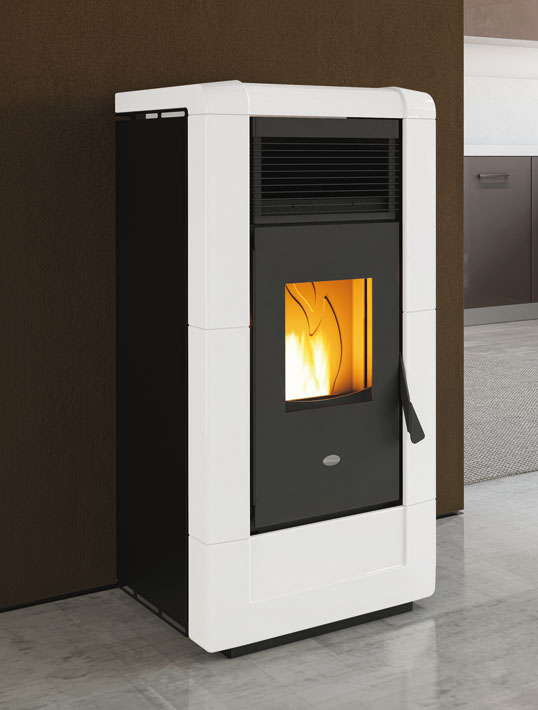
Constructions
The design of cast-iron or steel stoves for long-burning wood consists of the following elements:
- metal case on legs or a heat-insulating base to protect the floor;
- firebox;
- damper made of transparent heat-resistant glass;
- ash pan for collecting soot;
- cast iron grate;
- branch pipe for the output of combustion products;
- air channels to ensure a stable combustion process.
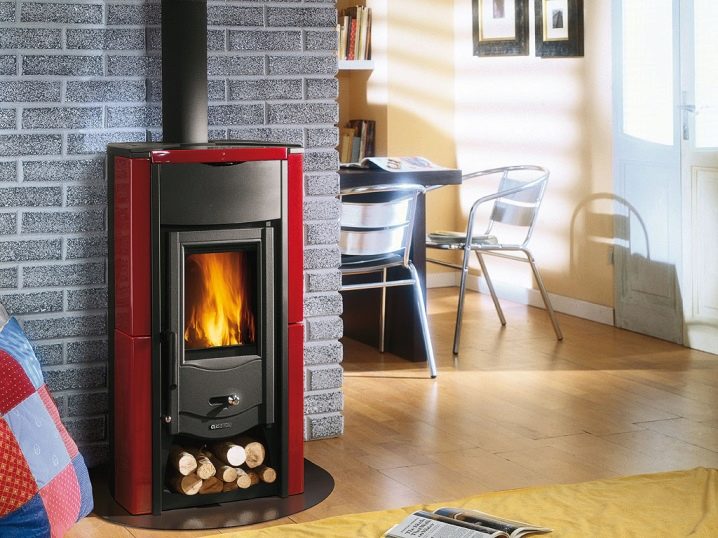
The operation of such a heating device is based on the long-term combustion of fuel due to enhanced gas formation processes. That is, in the furnace there is not intense burning, but a slow smoldering of firewood. This releases a large amount of gas. Due to it and the access of additional oxygen through the nozzles, the gaseous combustion products pass through the stage of secondary afterburning. The result is a minimum of waste, and the efficiency of the stove increases.
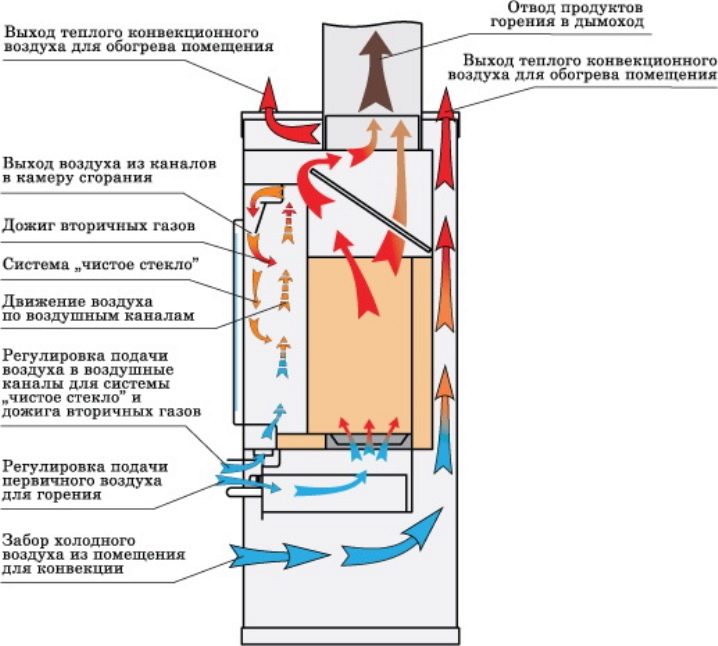
Another common design of long-burning stoves is based on the gradual advancement of the flame in the stacked firewood from top to bottom. Such a process greatly increases the time until the fuel is completely consumed, and no less heat is released. As an example, consider a burning match - if its head is directed upwards, then the flame will move down very slowly, if you tilt the head down, then the match will burn out in a very short time.
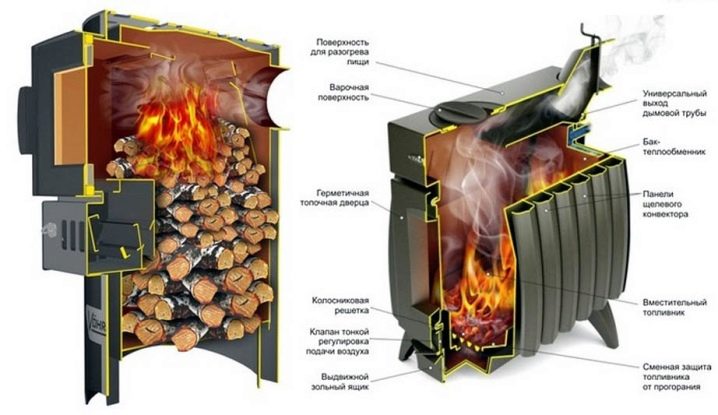
The design of a long-burning heating device with a vertical downward movement of the flame is called the Bubuafonya furnace by the name of its developer. In its firebox there is a movable disk, which plays the role of a piston, which descends as the top layer of firewood burns. There are gaps between the disk and the walls of the furnace boiler through which the resulting smoke rises and exits through the chimney. From above, the furnace is equipped with an air duct for the oxygen necessary for combustion to enter inside, the horizontal chimney from the furnace is connected to the chimney leading to the street. In addition, this design provides a container for collecting condensate.
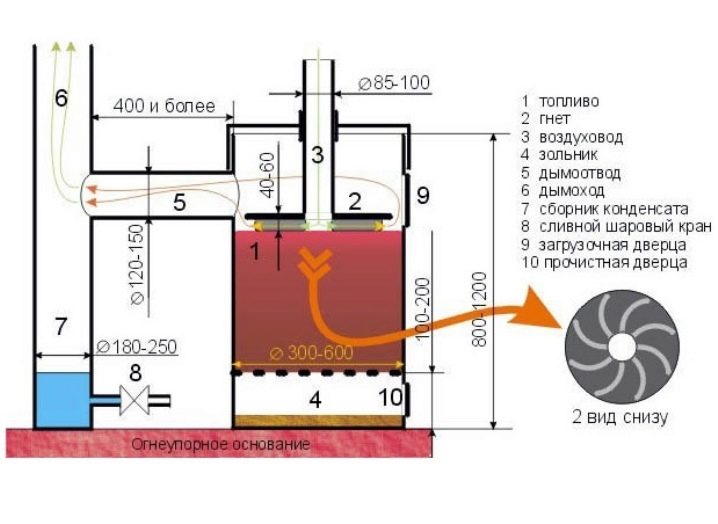
Not only wood is used as fuel, there are varieties of long-burning stoves on coal and peat briquettes. They have a higher specific heat of combustion, but wood firewood is better suited for creating a cozy atmosphere, a pleasant smell of a fire and an aesthetic appearance in the firebox of such a fireplace.
Fireplace stoves with a water circuit consist of almost the same elements as the usual type, which is used to heat one room. But around the firebox they have a heat exchanger in the form of a radiator or spiral. It consists of metal pipes through which water circulates. When heated, the liquid enters the heating systems distributed throughout the house.
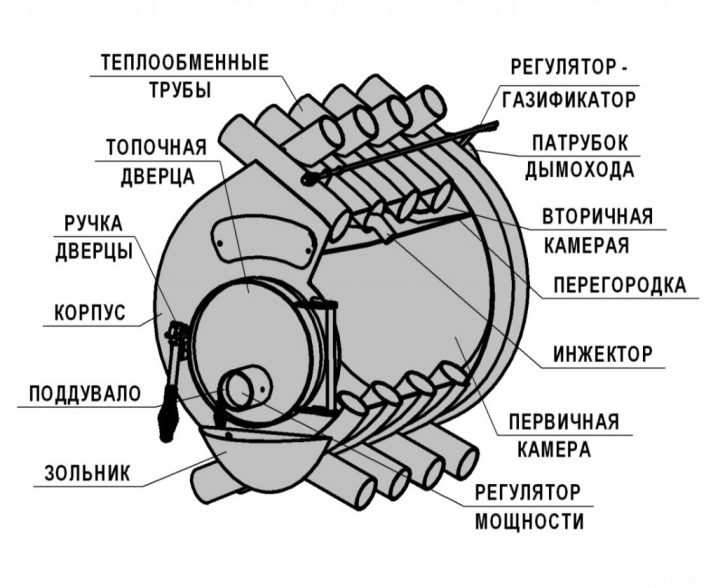
In addition to buying factory models with a water or air circuit, you can create a project and build fireplaces according to your taste and needs, for example, brick, stone, monolithic. This method is unique in that it is possible to create a fireplace portal with a firebox of any size, and, accordingly, of any power - for large buildings with several floors.
If a ready-made cast-iron or steel fireplace stove with a heating circuit is purchased, then the operating power is indicated in its technical data sheet. Based on this value, a model is selected depending on the area of \u200b\u200bthe building:
- 60-200 sq. m. - up to 25 kW;
- 200-300 sq. m. - 25-35 kW;
- 300-600 sq. m. - 35-60 kW;
- 600-1200 sq. m. - 60-100 kW.
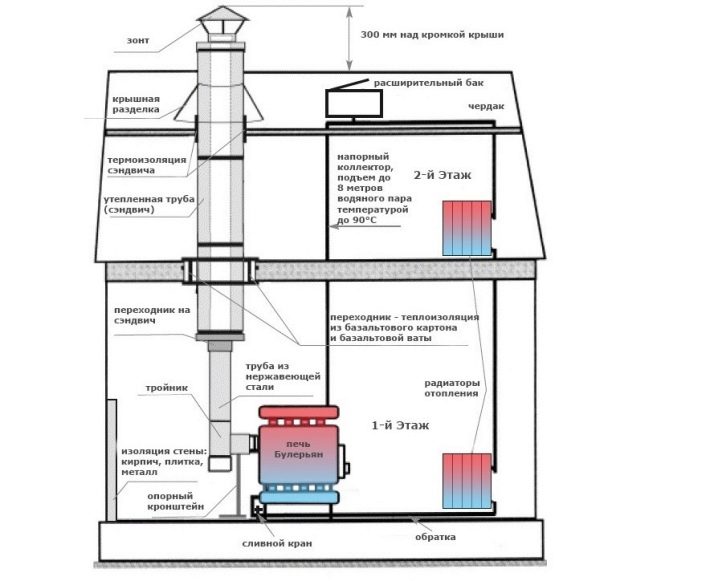
DIY
It is easiest to create a long-burning stove for a country house by purchasing a finished cast-iron firebox. There are several varieties of them:
- wall-mounted - designed for mounting in a fireplace near the wall, they will be closed with masonry on three sides, and on the front side there is a transparent damper;
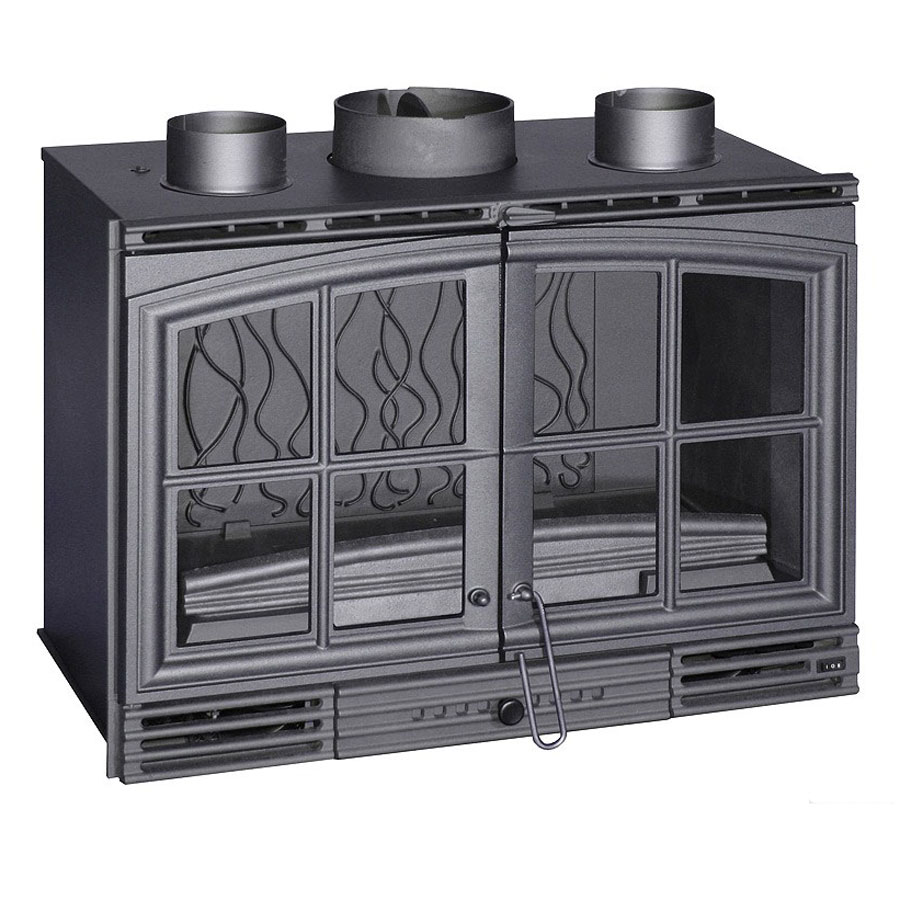
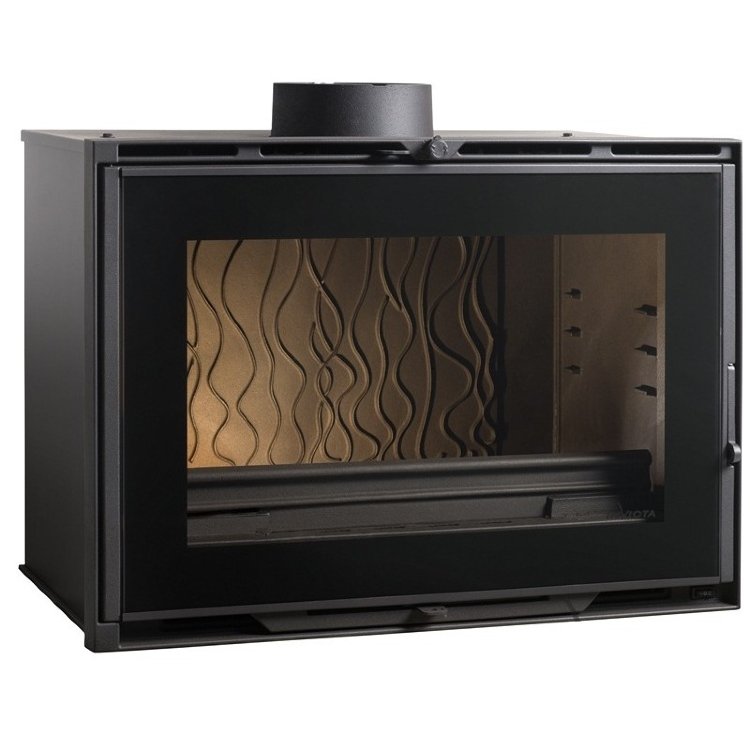
- corner fireboxes - installed in the corner type of fireplace;
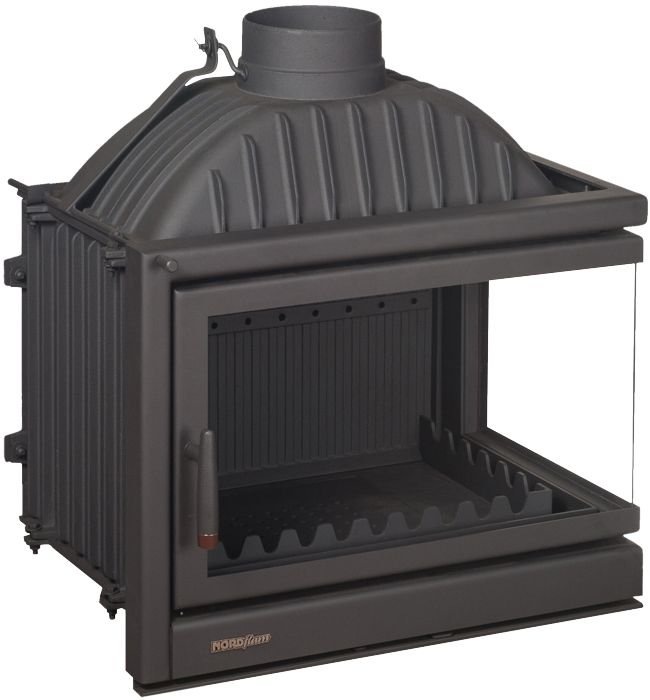
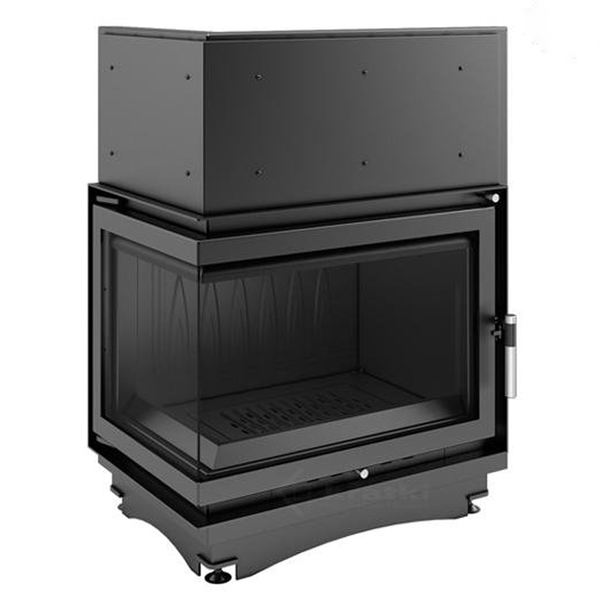
- double-sided models have transparent dampers on opposite sides and are suitable for simultaneous heating of two adjacent rooms;
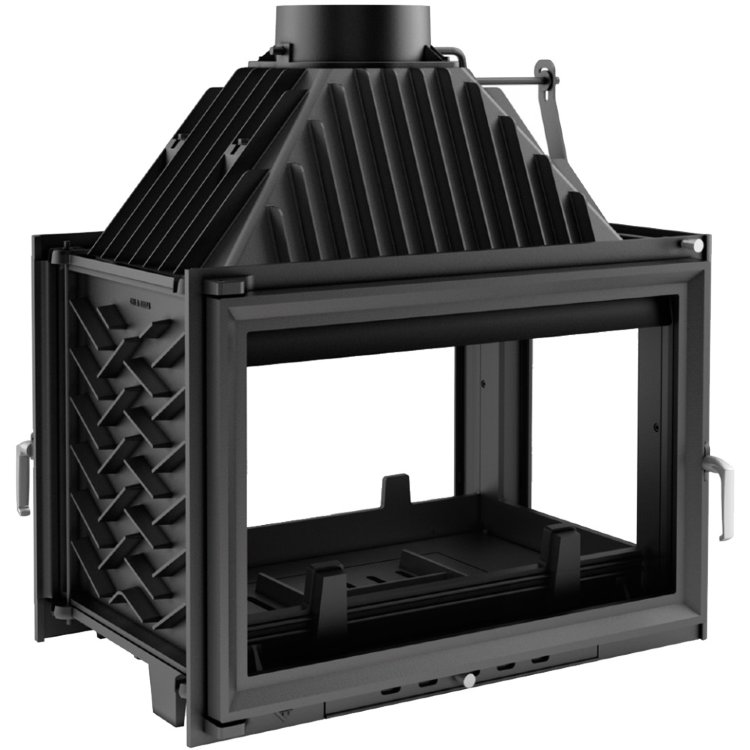
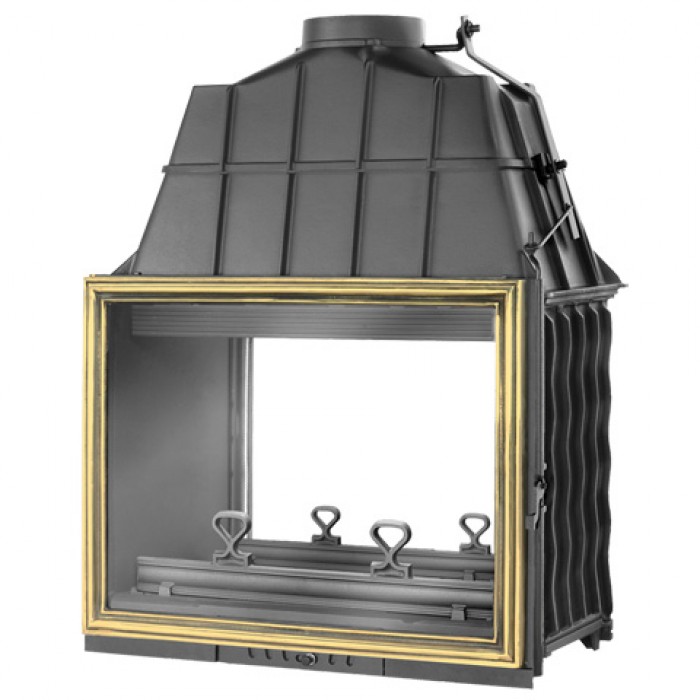
- with a heat exchanger for output to the heating circuit.
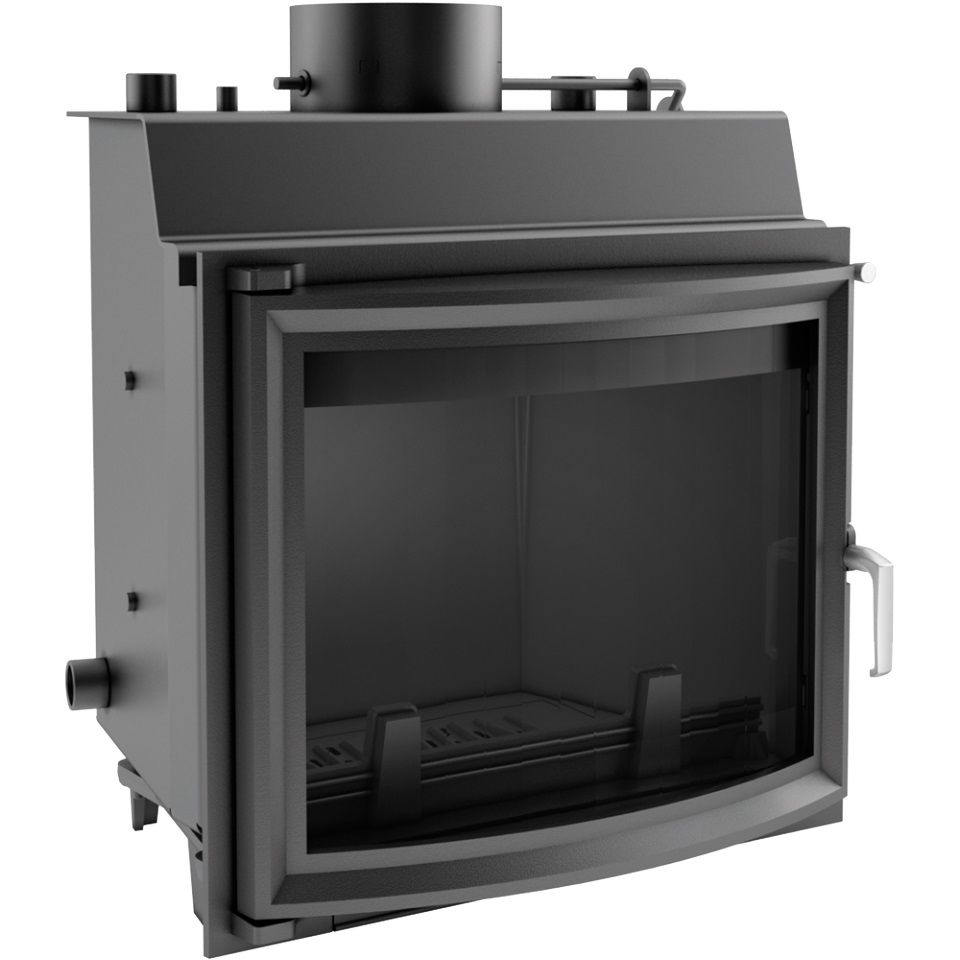
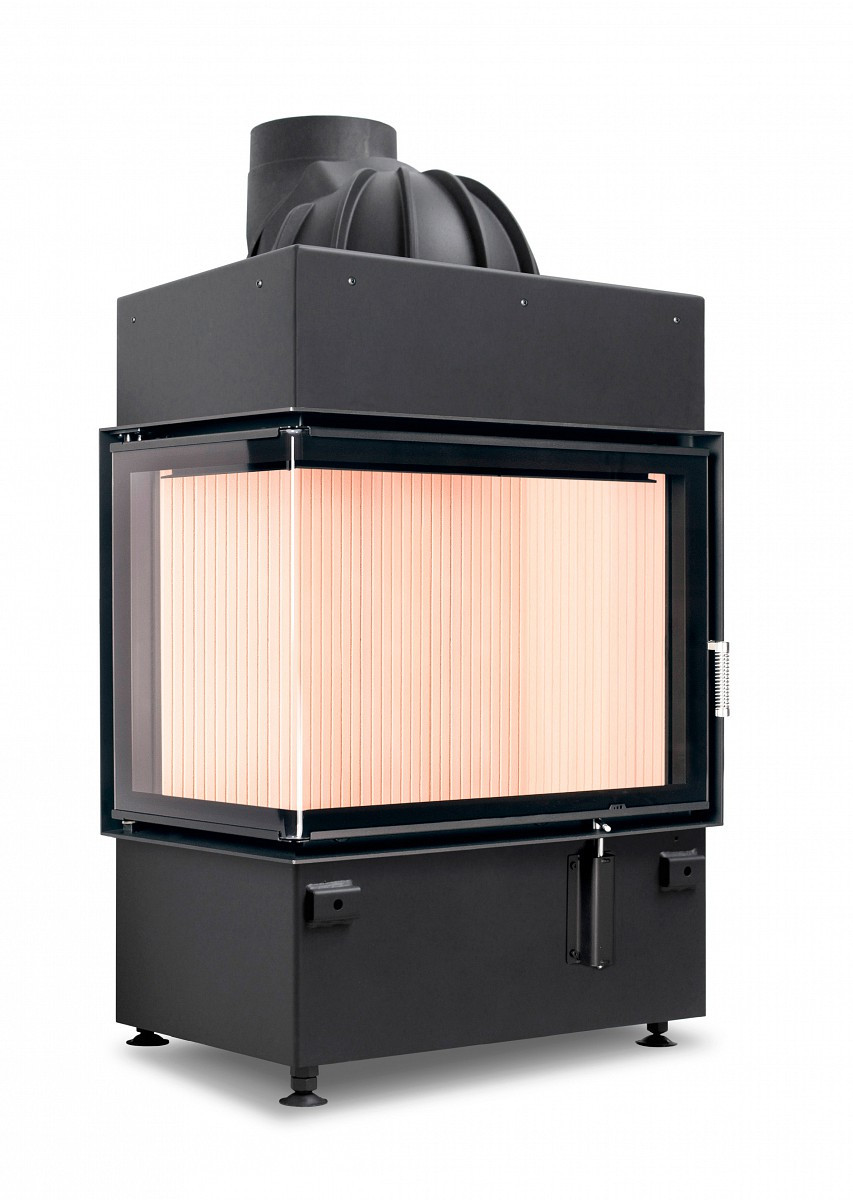
After the firebox is purchased, you need to create a fireplace project with facade cladding around it. Here you need to consider whether the metal heating cabinet has legs from below or protection against high temperatures. If it is not there, then it is necessary to build a heat-resistant base of concrete, brick or ceramics in the floor.
Facing the facade of the fireplace with a finished firebox is best done with refractory ceramic or clay bricks in one layer. After the masonry is completed, one should not immediately take on a full kindling. It is necessary that the solution is completely dry and the walls shrink. This will take 2 to 4 weeks. During this time, it is worth drying the fireplace. To do this, it is necessary to heat it daily with a small amount of dry firewood, no more than 2 kg.



